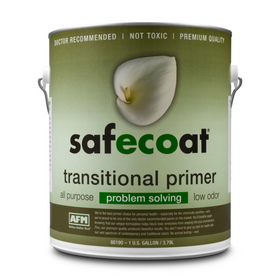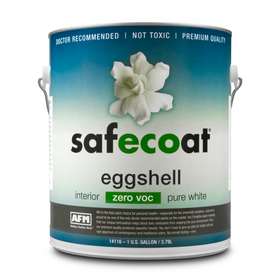
Milk Paint: It's a Thing and is Surprisingly Good for Your Home
Last Updated: Feb 11, 2025The next time you are cleaning out your refrigerator after a long vacation away from home, you might want to think twice about throwing away an old gallon of milk that is going sour—because it might still be of use. Before the day and age of commercial paints, many homeowners would mix their own paint from leftover milk. Milk paint, also known as casein paint, has been used since at least the time of the ancient Egyptians and offers a durable, non-toxic paint option for homeowners that can spice up your walls, cabinetry, furniture, and other interior elements of your home with a matte, antique-looking finish.
Table of Contents
- The Problem with VOCs from Paint
- What is Milk Paint?
- Is Milk Paint Environmentally Friendly?
- Top Suppliers of Milk or Casein Paint

The Problem with VOCs from Paint
By now, most homeowners probably understand that the “new” smell of a freshly painted home is usually not a good thing. Volatile organic compounds, or VOCs, are emitted as gasses from certain solids or liquid chemical products. While some VOCs may be extremely short-lived and have limited health effects, others can cause major health issues.
The Environmental Protection Agency (EPA) states that “concentrations of many VOCs are consistently higher indoors (up to ten times higher) than outdoors.” The report goes on to say that “organic chemicals are widely used as ingredients in household products. Paints, varnishes, and wax all contain organic solvents, as do many cleaning, disinfecting, cosmetic, degreasing, and hobby products. Fuels are made up of organic chemicals. All of these products can release organic compounds while you are using them, and, to some degree, when they are stored.”
Negative health effects from high concentrations of VOCs inside the homes we live in include eye, nose, throat irritation, headaches, nausea, damage to the liver, kidney, central nervous system, and even cancer. While there are many zero VOC interior paint options on the market today, many of these products don’t include the VOCs that come with the tints or colorants added to the paint base. For this reason, even the EPA encourages homeowners to look into alternative, natural paint alternatives, including paints made from lime, milk protein, clay, and earth-based pigments.
What is Milk Paint?
Milk paint is a natural paint that relies on the natural milk proteins generated by the curdling process, which is the same as what occurs when making cheese. This type of paint offers a long-lasting, beautiful, matte finish for our homes' interior and exterior. For homeowners wanting to experiment with their own milk paint, take a gallon of skim milk out of the refrigerator and let it warm to room temperature. Then, mix one quart of milk with a half cup of white vinegar to start the natural curdling process. Within an hour, you should see the milk solids (or curds) rising to the top of the bowl. Cover the milk and vinegar bowl in a warm place in a kitchen for 1 to 2 days to let the milk finish curdling.

When all of the milk solids have separated from the liquid whey, strain the milk mixture with a cheesecloth to separate the curds from the whey. The curds are then mixed with a bit of lime paste (powdered, hydrated lime, and water) to help break the curds into a smooth texture. Add a natural, dry pigment of choice, strain one more time to get rid of any solids or chunks that might remain, and you have a natural paint product for your home. You will only want to make as much fresh milk paint as you can use within 1-2 days, as the fresh milk paint proteins can get rotten. When applying milk paint onto your walls, you might detect a slightly sour smell, but that smell will disappear once the paint dries within an hour or two.
Is Milk Paint Environmentally Friendly?
Milk paint offers several benefits both for our health and for the natural environment. When combined with natural, earthen, or mineral pigment powders, such as those offered by Earth Pigments, milk paint will have absolutely zero VOCs. Whereas even the greenest commercial paints will contain additives and distillates that can cause several negative environmental effects, milk paint will cause absolutely no environmental harm. It can be much more safely disposed of as well.
Milk paint is naturally alkaline, meaning that it is a natural inhibitor of mold and mildew growing inside your home. Not only will milk paint help you avoid VOCs' health problems from paint, but it can also actively improve your indoor air quality by hampering mold growth.
Top Suppliers of Milk or Casein Paint
While you might have trouble finding milk or casein-based paint in the paint aisle at Home Depot or other large hardware stores, the growing interest in healthy home interiors had led to an explosion of artisanal paint companies that manufacture powdered milk paint products and market them online. Not only are these products more environmentally sustainable and healthier for you and your family, but opting for these paint options will support small retailers and entrepreneurs. Below, we look at a few of these smaller companies that offer powdered milk products online.
Real Milk Paint Company
Real Milk Paint Company. This company’s name says it all. Their wide range of milk paint products is designed to adhere to various substrates, including raw wood, plaster, drywall, stone, and even unsealed brick and concrete. There is no need for primers if you are painting on wood or other porous surfaces. The water-based formula is easy to use, as you will only need to add water to prepare your paint. For large projects, the paints offered by the Real Milk Paint Company remain usable for a minimum of two weeks after mixing with water. Like most milk paint products, these products leave no residual odor after drying and will be completely dry to the touch within 30 minutes to 4 hours, depending on the ambient indoor temperature. You can download the milk paint color chart offered by the company and find a tutorial on using milk paint for your home interior. Most of the gallon-sized containers of the Real Milk Paint Company's milk pain cost around $60.

Homestead House Paint Company
Homestead House Paint Company offers authentic milk paint that can provide a durable and hard as a stone finish for interior and exterior applications. Their milk paint is guaranteed never to chip or peel when applied to a porous surface like wood. It is also naturally molded resistant while providing a completely breathable coating. The Homestead House Paint Company sells a special bonding agent specifically designed to be used with their milk paints when applied on varnished or lacquered surfaces such as ceramic tiles or even glass. This company offers bulk-sized paint products for large projects. A 10-pound bag can cover anywhere between 1,400 and 1,500 square feet of surface area and should be enough to paint a large kitchen, including all cabinets and an island. Ten pound bags start at $259.99 CAD (about $200 USD).

Miss Mustard Seed Milk Paint
One quart of milk paint manufactured by Miss Mustard Seed Milk Paint can cover approximately 70 square feet of the wall surface. Like other milk paint products, it is easy to use and only requires mixing the powder with water. Depending on the amount of water added to the pigmented powder, milk paint application can range from a solid color to a stain. It can also be used on any porous surface without primer, as the product is designed to soak into and absorb the substrate. Their wide range of colors of 100% naturally pigmented milk paint starts at $23 for a quart of paint, and you can find a list of online retailers that sell Miss Mustard Seed Milk Paint here.
How do prices compare to conventional zero-VOC paints? With paints, pricing often depends more on the brand and can range from about $30 to $60 per gallon—so, at closer to $60 to $80 per gallon, milk paint can be pricier. But you can also stretch the paint further by adding more water, depending on the aesthetic you are going for. So if you are looking for more of an antique look and feel and want to experiment with healthier choices for your home, milk paint is worth checking out.
Tobias Roberts
Tobias runs an agroecology farm and a natural building collective in the mountains of El Salvador. He specializes in earthen construction methods and uses permaculture design methods to integrate structures into the sustainability of the landscape.












